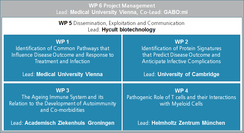Methodologies/Approach
The RELENT Consortium was formed to address the unmet need for better ways to individualise the treatment of chronic autoimmune and inflammatory diseases thereby reducing the unacceptably high morbidity and mortality they cause.
The RELENT research project is based on the principle that complex human diseases are best studied using samples taken from large cohorts of well-characterised patients, using murine models, preferably “humanised” models, in parallel to analyse cellular interactions that can only be studied in vivo. The RELENT Consortium partners and others have demonstrated the existence of common pathways that influence both susceptibility to, and outcome of, a number of distinct chronic immune-mediated diseases.
The RELENT Partners have adopted a methodological approach that has proved highly effective in the past and will focus on a single disease, ANCA-Associated Vasculitis (AAV), for unbiased pathway discovery before extending the findings to other diseases. We propose to:
- Perform a genome-wide association study of disease outcome, similar to the one that identified functional FOXO3 mutations in Crohn’s disease, for new pathway discovery and characterisation.
- Use cells differentiated from iPSCs generated from patients and healthy controls to analyse the effects and functional consequences of newly discovered genetic variants as well as extending the characterisation of FOXO3 variants.
- Apply high-throughput protein arrays, proteomics platforms and novel mass spectrometry approaches to identify serum biomarkers associated with clinical parameters.
- A CD8 T cell transcriptomic signature, that reflects T cell exhaustion, predicts disease outcome. Accordingly, we will exploit the observation that the frequency of T cell exhaustion and autoimmune disease both increase with age to explore the links between them in the SENEX cohort of elderly patients.
- Use mouse models including strains expressing human ANCA targets and human HLA class II molecules to analyse the unanticipated role of CD8 T cells, the control of T cells by renal dendritic cells and the interactions of ANCA targets and other proteases together with their inhibitors in generating persistent tissue injury.







